You can Download KSEEB Solutions for Class 8 Maths Chapter 3 Understanding Quadrilaterals Ex 3.1 Questions and Answers helps you to revise the complete syllabus.
KSEEB Solutions for Class 8 Maths Chapter 3 Understanding Quadrilaterals Ex 3.1
Question 1.
Given here are some figures.

Classify each of them on the basis of the following.
(a) Simple curve
(b) Simple closed curve
(c) Polygon
(d) Convex polygon
(e) Concave polygon
Solution:
(a) Simple curve: (i), (ii), (v), (vi), (vii)
(b) Simple closed curve: (i), (ii), (v), (vi), (vii)
(c) Polygon: (i), (ii), (iv)
(d) Converx polygon: (ii)
(e) Concave polygon: (i), (iv)
![]()
Question 2.
How many diagonals does each of the following have?
(a) A convex quadrilateral
(b) A regular hexagon
(c) A triangle
Solution:
(a) A convex quadrilateral has two diagonals.
(b) A regular hexagon has 9 diagonals.
(c) A triangle has no diagonal.
Question 3.
What is the sum of the measures of the angles of a convex quadrilateral? Will this property hold if the quadrilateral is not convex? (Make a non-convex quadrilateral and try!)
Solution:
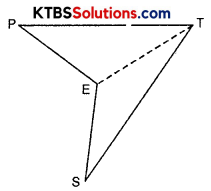
PEST is a convex polygon
In ∆PET
∠P + ∠PTE + ∠PET = 180° ………(i)
In ∆SET
∠S + ∠SET + ∠STE = 180° ……..(ii)
Adding (i) and (it)
∠P + ∠S + ∠PTE + ∠PET + ∠SET + ∠STE = 360°
∴ ∠P + ∠S + ∠T + ∠PES = 360°
Yes, this property holds, if the quadrilateral is not convex.
![]()
Question 4.
Examine the table. (Each figure is divided into triangles and the sum of the angles deduced from that.)

What can you say about the angle sum of a convex polygon with a number of sides?
(a) 7
(b) 8
(c) 10
(d) n
Solution:
(a) Sum of angles = (7 – 2) × 180° = 900°
(b) Sum of angles = (8 – 2) × 180° = 1080°
(c) Sum of angles = (10 – 2) × 180° = 1440°
(d) Sum of angles = (n – 2) × 180° = (n – 2) 180°
Question 5.
What is a regular polygon?
State the name of a regular polygon of
(i) 3 sides
(ii) 4 sides
(iii) 6 sides
Solution:
A regular polygon is both equiangular and having all sides of equal measure.
(i) If there are three sides of a regular polygon, then it is an equilateral triangle.
(ii) Four sides of a regular polygon are called squares.
(iii) Six sides of a regular polygon are called a hexagon.
Question 6.
Find the angle measure x in the following figures:
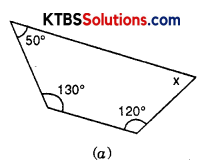
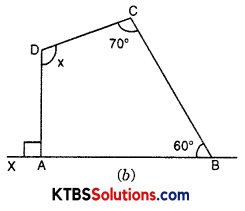
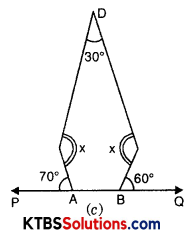
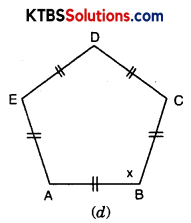
Solution:
(a) Since, the figure is a quadrilateral, then the sum of angles is 360°
Hence, 50° + 130° + 120° + ∠x = 360°
⇒ ∠x + 300° = 360°
⇒ ∠x = 360° – 300°
⇒ ∠x = 60°
(b) ∠DAX = 90°
∠DAX + ∠DAB = 180° (Linear pair)
⇒ ∠90° + ∠DAB = 180°
⇒ ∠DAB = 180° – 90°
⇒ ∠DAB = 90°
Now in quadrilateral ABCD
∠A + ∠B + ∠C + ∠D = 360°
⇒ 90° + 60° + 70° + ∠x = 360°
⇒ 220° + ∠x = 360°
⇒ ∠x = 360° – 220°
⇒ ∠x = 140°
![]()
(c) ∠EAP + ∠EAB = 180° (Linear pair)
⇒ 70° + ∠EAB = 180°
⇒ ∠EAB = 180° – 70°
⇒ ∠EAB = 110°
Again, ∠CBQ + ∠CBA = 180° (Linear pair)
⇒ 60° + ∠CBA = 180°
⇒ ∠CBA = 180° – 60°
∴ ∠CBA = 120°
ABCDE is a pentagon
∠A + ∠B + ∠C + ∠D + ∠E = 540°
⇒ 110° + 120° + x + 30° + x = 540°
⇒ 260° + 2x = 540°
⇒ 2x = 540° – 260°
⇒ 2x = 280°
⇒ x = 140°
(d) Since, the given pentagon is a regular pentagon. Hence, all its angles are equal.
∴ ∠x + ∠x + ∠x + ∠x + ∠x = 540°
⇒ 5∠x = 540°
⇒ ∠x = 108°
Question 7.
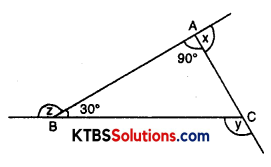
(a) Find x + y + z
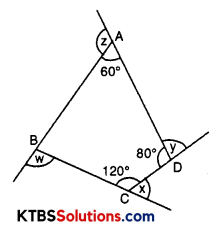
(b) Find x + y + z + w
Solution:
(a) ∠z + 30° = 180° (Linear pair)
⇒ ∠z = 180° – 30° = 150°
∠x + 90° = 180° (Linear pair)
⇒ ∠x = 180° – 90° = 90°
In ∆ABC, ∠A + ∠B + ∠C = 180°
⇒ 90° + 30° + ∠C = 180°
⇒ 120° + ∠C = 180°
⇒ ∠C = 180° – 120° = 60°
Now ∠C + y = 180° (Linear pair)
⇒ 60° + y = 180°
⇒ y = 180° – 60°
⇒ y = 120°
Hence, x = 90°, y = 120°, z = 150°
![]()
(b) ABCD is a quadrilateral
∠A + ∠B + ∠C + ∠D = 360°
⇒ ∠60° + ∠B + 120 + 80° = 360°
⇒ ∠B + 260° = 360°
⇒ ∠B = 360° – 260° = 100°
Now ∠z + 60° = 180° (Linear pair)
⇒ ∠z = 180° – 60° = 120°
∠w + ∠B = 180° (Linear pair)
⇒ ∠w + 100° = 180°
⇒ ∠w = 180° – 100°
⇒ ∠w = 80°
Now 120° + ∠x = 180° (Linear pair)
⇒ ∠x = 180° – 120° = 60°
Again, ∠y + 80° = 180° (Linear pair)
⇒ ∠y = 180° – 80°
⇒ ∠y = 100°
∴ ∠x = 60°, ∠y = 100°, ∠z = 120°, ∠w = 80°